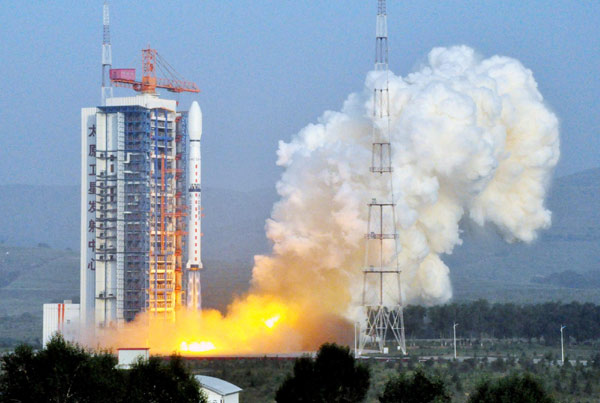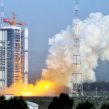
PLA Expands Network of Military Reconnaissance Satellites
Publication: China Brief Volume: 10 Issue: 17
By:

On August 9, China launched the remote sensing satellite Yaogan-10 (military designation: Jianbing) into orbit from the Taiyuan Satellite Launch Center. Situated in the northwest of Shanxi Province, the site is a space and defense launch facility reportedly used for testing the Chinese military’s intercontinental ballistic missiles and overland submarine-launched ballistic missiles (Globalsecurity.org). This event marks the sixth Chinese launch this year via the CZ-4C Chang Zheng-4C (Long March) launch vehicle and follows a surge in satellite launches that appear to reflect the Chinese determination to beef up its reconnaissance satellite network and end its dependence upon foreign satellite systems. While China’s exact intentions are unknown, given the dual use-nature of remote sensing satellites, China is rapidly improving its diverse network of space-based Intelligence, Surveillance and Reconnaissance (ISR) sensors, which can bolster the Chinese military’s expanding land, sea and air operations (Nasaspaceflight.com, August 9; Xinhua News Agency, August 10).
The state-run Xinhua News Agency reported that Yaogan-10 will conduct “scientific experiments, carry out land surveys, estimate crop yields and help respond to natural disasters” (Xinhua News Agency, August 10), yet there is evidence to suggest that the Yaogan satellite is also a military asset, with some models equipped with the synthetic aperture radar (SAR) system designed to observe locations in all weather and lighting conditions.
The Yaogan series is a new fleet of high-resolution optical and radar reconnaissance satellites in China’s growing space-based sensor network. With alternating take offs from the Taiyuan and the Jiuquan site, China has been launching this series of radar and electro-optical spy satellites into orbit since 2006. The launch of Yaogan-9, purportedly for ocean surveillance and targeting from the Jiuquan Satellite Launch Center in Inner Mongolia, on March 5 included three spacecraft (i.e. Yaogan-9A, Yaogan-9B, and Yaogan-9C), which are believed to be naval observation satellites. According to observers, three such satellites flying in formation in orbit form what appear akin to a type of Naval Ocean Surveillance System (NOSS)—and may be used for gathering intelligence derived from ships and aircraft by their radar and other electromagnetic radiation.
The development of a space-based SAR system has been a priority for the People’s Liberation Army (PLA). Such a system is considered a critical component to the PLA’s effort in achieving information dominance in future warfare. According to Andrew Erickson, associate professor at the China Maritime Studies Institute at the U.S. Naval War College, "Synthetic Aperture Radar [SAR] in particular offers wide coverage at sufficient resolution. Maritime surveillance, prioritized at the national level under China’s 863 State High-Technology Development Plan, is receiving significant funding" (Asia Times, April 22).
"Of particular note are the five Yaogan satellites that China has launched in the past five months. Yaogan-7 and 8 were launched in December. Yaogan-7 is optical and Yaogan-8 appears to be equipped with SAR," said Erickson. "Yaogan 9A, 9B, and 9C, launched in March, share the same orbit, suggesting that they have a special mission to perform" (Asia Times, April 22).
According to the website Nasaspaceflight.com, the Chinese schedule for the rest of the year may include the launch of at least another remote sensing satellite, the Chinasat-6A communications satellite, the ST-1B Shen Tong-1B / ZX-20 (2) ZhongXing-20 (2) military communications satellite and two more Beidou (COMPASS) navigation satellites (Nasaspaceflight.com, August 9).
The main contractors for the SAR satellite system include China Academy of Science’s Institute of Electronics, Shanghai Academy of Spaceflight Technology, 501 and 504 Institutes of China Academy of Space Technology, Nanjing Research Institute of Electronic Technology, Southwest Institute of Electronic Equipment and Beijing University of Aeronautics & Astronautics (BUAA).
To be sure, the launch of Yaogan-10 foreshadows the coming of age of China’s second-generation SAR satellite system. According to a BUAA report, the development of a second-generation SAR Satellite program had been listed in China’s 11th Five-Year Development Plan (2006-2010) (Sinodefence.com). The new system is expected to strengthen the PLA’s all-weather-targeting applications for locating enemy assets in China’s periphery. The space-based SAR system can penetrate multiple layers to detect targets on the ground or underground, and in the ocean. In addition, SAR satellites can be used for tracking moving targets (e.g. aircraft carrier) and military mapping requirements.
Whether the launch of Yaogan-10 represents a leap in China’s space program remains to be seen. At the very least it is a continuation of China’s concerted push to strengthen its space-based infrastructure. As China’s missile program grows in number and sophistication, these developments suggest that the PLA is rapidly developing an employable capability that will assist it in achieving its operational and strategic objectives.





